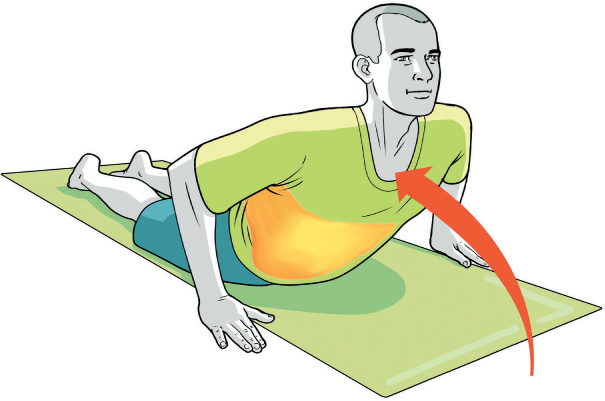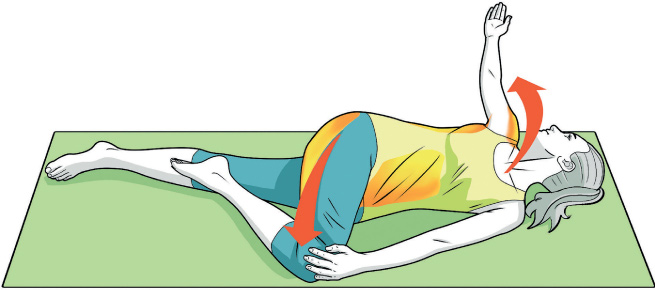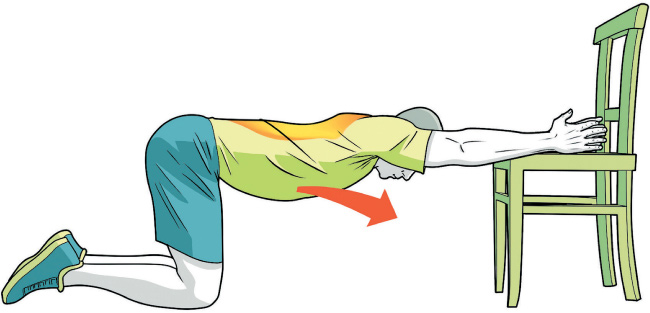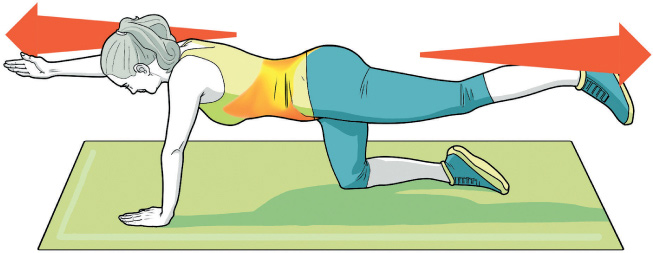
Upper back (thoracic spine )
This technique loosens your upper back, a.k.a. your thoracic spine, a key series of joints that we use when we perform any rotational movements, such as swinging a tennis racket or shoveling snow. This exercise requires a foam roller.
WARM-UP • COOL-DOWN • PROP (FOAM ROLLER)
INSTRUCTIONS
1. Sit on the ground with your knees bent and feet on the floor. Place a foam roller behind your back near your shoulder blades.
2. Cross your arms over your chest and roll your body back so the middle of your back ends up on top of the foam roller.
3. Move your body back and forth on the foam roller, using small (2- to 6-inch) continuous movements over your mid and upper back, applying gentle pressure to any tender areas where you feel discomfort.
CHANGE IT UP
• If you have a particularly sore and tender spot on your back, apply pressure near, but not directly over, the area and hold for up to 60 seconds.
• To enhance the feeling of release you get from this move, position your foam roller directly over the tender area you are targeting and apply pressure, holding the position for up to 30 seconds.
In addition to moving back and forth, allow your spine to drape over the foam roller, almost as if you were performing subtle mini crunches. This gentle arching of your upper back will help increase its extension, which can make your shoulders feel less restricted when you lift your arms overhead to put away groceries or dishes in high cabinets.
Torso (abdominals )
Inspired by yoga, this move stretches your abdominal muscles and is a great counterbalance to spending many hours seated at a desk or driving a car, where your upper back may be in a rounded position and cause lower-back pain. Also, by loosening your abdominal muscles, you improve your breathing, which can become restricted if abdominal muscles are tight.
COOL-DOWN • STATIC
INSTRUCTIONS
1. Lie on your stomach with your elbows bent and your hands below your shoulders. Stretch out your legs, hip-width apart, resting the tops of your feet on the floor.
2. Keep your palms and the tops of your feet pressed into the floor. Inhale as you slide your chest slightly forward and lift it off the floor. Engage your glutes (buttocks) and extend your elbows slightly while keeping your arms close to your body. Hold this position.
3. Exhale as you lower your chest back to the floor.
CHANGE IT UP
• For an easier stretch that still targets the same muscles, lie on your back with a rolled towel beneath the small of your back. This support will help minimize the pressure placed on your spine.
• To increase the intensity of this stretch, extend your elbows fully and lift your chest, belly, and thighs off the floor, coming into upward-facing dog.

To move into this stretch safely, start by sliding your chest slightly forward before lifting it off the floor. In addition, engaging your glutes when arching your spine relieves some of the stress on your lower back.
Back (thoracic spine ), torso (abdominals ), ankles, and neck
This dynamic motion exercise helps loosen your upper back and gets you ready to tackle everyday tasks, while also effectively warming you up for various activities, like dancing, swimming, and cycling.
WARM-UP • DYNAMIC
INSTRUCTIONS
1. Begin in a hands-and-knees position, with your wrists aligned below your shoulders and your knees aligned below your hips. Keep your spine extended and your toes tucked under.
2. Inhale, relax your belly so it moves toward the floor, and gently arch your back, tilting your tailbone and chin toward the ceiling.
3. Exhale, gently round your spine, draw your chin toward your chest, and untuck your toes, placing the tops of your feet on the floor.
4. Repeat this sequence of movements.
CHANGE IT UP
• To make this move easier, do it in a seated position, either on the floor or in a chair. Place your palms on top of your thighs and gently round and arch your back.
• To modify this movement, round your spine as you exhale while simultaneously shifting your hips back toward your heels. When you inhale, shift your weight forward and return to all fours before softening your belly and arching your spine to continue the sequence.
With this exercise, you are moving rather than staying static, so focus more on the movement itself rather than on deepening the stretch.
Back, torso, and outer hips
This gentle twist relieves tension in your spine by stretching the muscles in your back. It also helps reduce any feelings of stress and anxiety you may have, making this a welcome stretch at the end of a busy day.
COOL-DOWN • STATIC
INSTRUCTIONS
1. While lying on your back with your knees bent and feet flat, stretch your left leg along the floor, keeping a slight bend in the knee.
2. Inhale, lift your right foot, and, with your hands, draw your right knee toward your chest.
3. Exhale, extend your right arm, palm facing up, out to your right side. With your left hand, gently guide your right knee across your body to fall outside your left hip.
4. Turn your head to look toward your right hand. Hold this stretch.
5. Switch sides and repeat.
• For more support, place a foam block on the outside of your hip and rest your bent knee on top of the block.
• To vary the sensation, scoot your hips slightly toward the direction of your outstretched arm and use your other hand as leverage on your bent knee to deepen the rotation and stretch.

Keep both shoulders in contact with the floor, or as close as you can, when you perform this twist.
Torso (obliques )
This stretch focuses on twisting your spine at the waist, an important movement that will reduce any lower-back pain you have and improve your posture.
COOL-DOWN • STATIC
INSTRUCTIONS
1. Stand with your feet hip-width apart, arms at your sides.
2. Inhale, sweeping your left arm toward the ceiling with your palm facing to the right.
3. Exhale, reach your left fingertips up and over toward your right side, leaning your torso to the right to stretch the left side of your body. Hold this stretch.
4. Switch sides and repeat.
CHANGE IT UP
• For an easier version of this stretch, do it seated on the edge of a chair with your feet flat on the floor, one arm relaxed at your side or resting on your thigh if you are using a chair with arms.
• For a deeper stretch, extend both arms up and overhead with palms pressed together.
To stretch the side of your body effectively, focus first on reaching your extended arm up before reaching over to the other side.
Back of shoulders, back (latissimus dorsi ), and upper back (rhomboids and trapezius )
If you experience pain in your shoulders, particularly around your shoulder blades, because of poor posture, this stretch will help. It can also be of benefit if you suffer from shoulder issues such as bursitis or frozen shoulder. Additionally, this stretch can make it easier for you to perform household duties that require reaching overhead.
COOL-DOWN • STATIC
INSTRUCTIONS
1. Stand with your feet hip-width apart, arms open wide.
2. Cross one arm over the other at your elbows, reaching your hands over your opposite shoulders as if giving yourself a hug.
3. Gently draw the shoulders forward. Hold this stretch.
CHANGE IT UP
• If it is too difficult to reach your shoulders, perform this stretch by grasping the upper portion of the opposite arm instead of your shoulder, drawing your forearms parallel with each other as you gently pull your shoulders forward.
• For a more intense stretch, use a doorway: Cross one arm in front of your body at shoulder height. Point your thumb down and extend your elbow while grabbing hold of the doorjamb. Rotate your body gently in the opposite direction to create your desired level of stretch. Repeat on the other side.
Each time you repeat this stretch, alternate crossing your arms and note whether one side feels more comfortable than the other.
Back (latissimus dorsi )
This stretch targets your latissimus dorsi, the large muscle of your back, and helps make everyday activities that involve reaching your arms overhead, such as taking something off a high shelf, as well as recreational activities like swimming, easier to perform. Additionally, when you stretch this key muscle, you help prevent shoulder pain and discomfort, including rotator cuff injuries.
COOL-DOWN • STATIC • PROP (BLANKET OR TOWEL)
INSTRUCTIONS
1. Start in a kneeling position, facing the seat of a chair or a couch, and rest your knees, hip-width apart, on a folded blanket or towel for additional comfort.
2. Keep your spine extended and bend at your hips to create a 90-degree angle with your body as you place your forearms, palms facing each other, on top of the seat in front of you. Hold this stretch.
• To make this stretch easier, start in a standing position and use a table or countertop instead of a chair. Keep your palms down to reduce the stretch.
• To deepen the stretch, turn your palms up to the ceiling or join them together and bend your elbows.

As you bend forward, keep your hips stacked over your knees and place your elbows close to the edge of the seat while actively outstretching your arms.
Torso (abdominals ), back (latissimus dorsi ), and lower legs/ankles (tibialis anterior )
This full-body stretch stretches your abdominal muscles, which can become tight as a result of poor posture and cause lower-back pain. Using the towel in this exercise helps reduce any undue pressure on your spine. Reaching your arms overhead while pointing your toes stretches your back and shins.
COOL-DOWN • STATIC • PROP (TOWEL)
INSTRUCTIONS
1. From a seated position with your knees bent and feet flat on the floor, place a small rolled towel beneath the small of your back. Recline into a lying position, stretching out your legs along the floor.
2. Inhale, stretch your arms over your head, palms facing the ceiling, allowing your arms and hands to touch the floor or draw as close to the floor as possible while keeping your back in contact with the towel. At the same time, point your toes away from your body. Keep your glutes (buttocks), upper back, and the back of your head in contact with the floor at all times. Hold this stretch.
• To support your lower back even more, keep your knees bent with your feet flat on the floor.
• For a more intense and deeper stretch, roll the towel into a slightly larger size to increase the stretch in your abs.

When performing this stretch, gently squeeze your buttocks to minimize the stress placed on your lower back. Keep your glutes, upper back, and the back of your head in contact with the floor at all times.
Torso
This dynamic motion exercise builds stability in your lower back, thereby reducing your risk of lower-back pain.
WARM-UP • DYNAMIC
INSTRUCTIONS
1. Begin in a hands-and-knees position with your wrists aligned below your shoulders and knees below your hips; your fingers should point forward.
2. Tuck your right toes under and extend your right leg behind you. Slowly lift your leg off the floor, raising it no higher than hip height.
3. Brace your core gently so you maintain an elongated spine. Slowly reach your left arm forward, no higher than shoulder height, and turn your palm to face inward while pointing your thumb toward the ceiling. Hold this extended position for no more than 7 to 8 seconds, keeping your hips and shoulders level.
4. Return to the starting position and repeat the movement on your opposite side.
• To make this easier, break this exercise down into two different movements. Focus first on extending your leg behind you, either keeping your toes on the ground or lifting them. Return to the starting position with both knees on the ground, before extending your opposite arm forward.
• For a variation, perform several repetitions (3 or 4) with your right leg/left arm, lowering your limbs just until they brush the floor between lifts. Switch sides and repeat this exercise with your opposite arm and leg (left leg/ right arm).

You’re more likely to build endurance by increasing the number of repetitions you do as opposed to holding your arm and leg extended for a longer period time. Therefore, hold the range of motion for no more than 7 to 8 seconds and avoid shifting your weight when alternating sides.
Upper back (thoracic spine )
This dynamic stretch increases your range of motion in your upper back, helpful for so many everyday movements—from reaching across your body to put on a seat belt to swinging a golf club.
WARM-UP • DYNAMIC
INSTRUCTIONS
1. Begin in a hands-and-knees position with your knees aligned below your hips and your wrists below your shoulders.
2. Draw your left fingertips behind your left ear, keeping your elbow bent and open to the side of your body.
3. Rotate your torso to your left, drawing your left elbow to point toward the ceiling.
4. Reverse the movement, returning your torso to your starting position parallel with the floor while crossing your left elbow toward your right arm. Continue this movement.
5. Switch sides and repeat.
CHANGE IT UP
• If your wrists or knees bother you when you are in a hands-and-knees position, try this dynamic stretch while seated, with both sets of fingers behind your ears and your elbows out wide.
• For a different variation, perform this rotational movement in a high-kneeling position with both sets of fingers behind your ears and your elbows wide. As you rotate in one direction, dip one elbow toward the ground, followed by the other, and twist a little bit more in the same direction to increase your range of motion.
To reduce pressure on your spine, visualize rotating your entire torso, including your head and neck, as one unit when moving in each direction, twisting from your upper back in a controlled fashion.